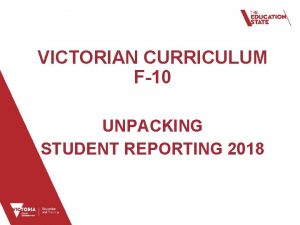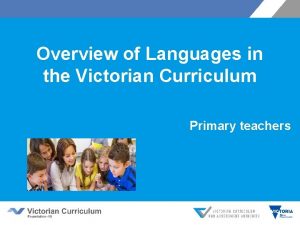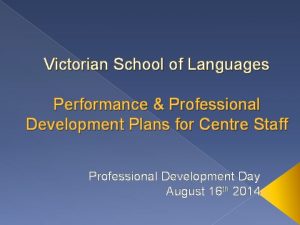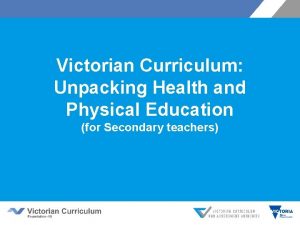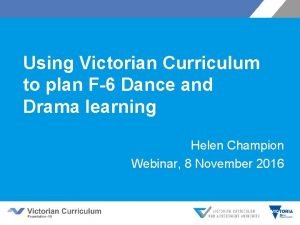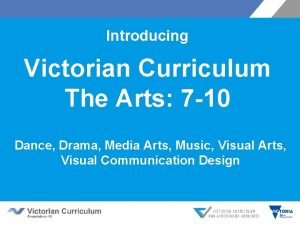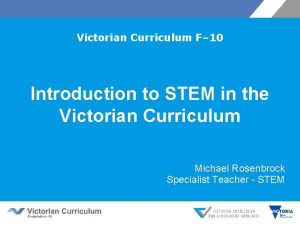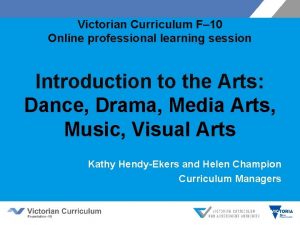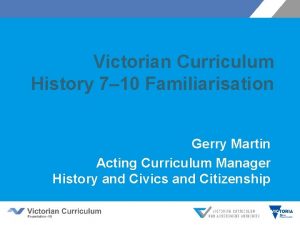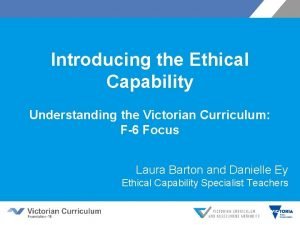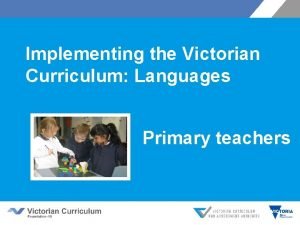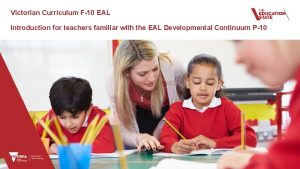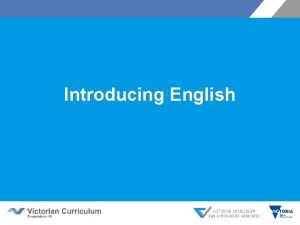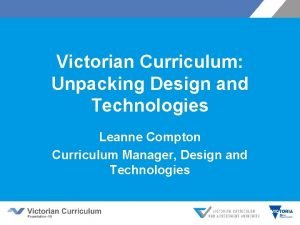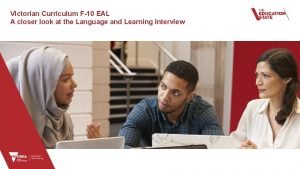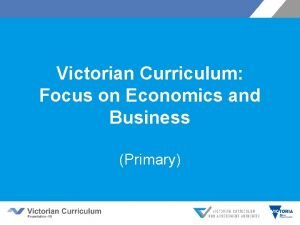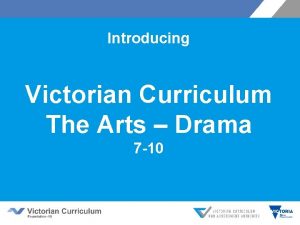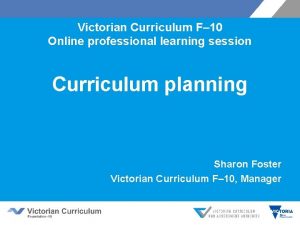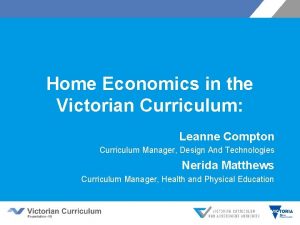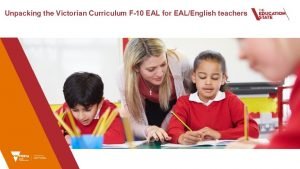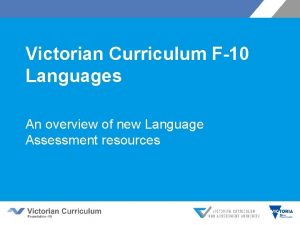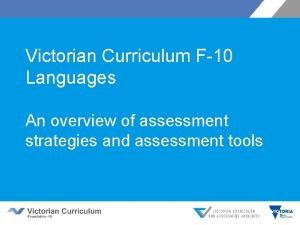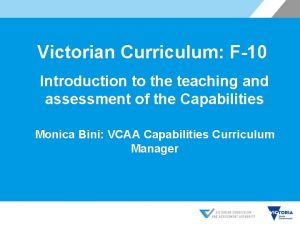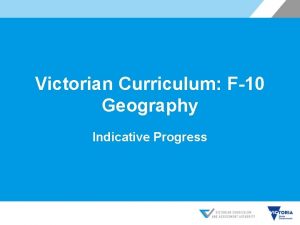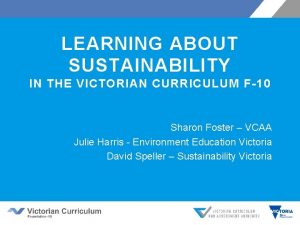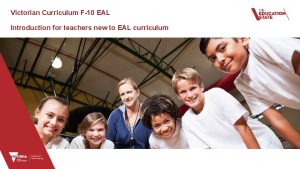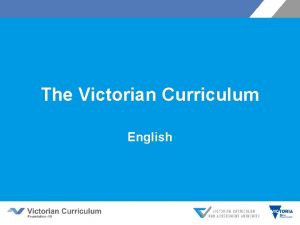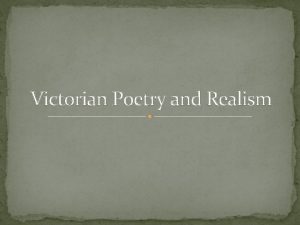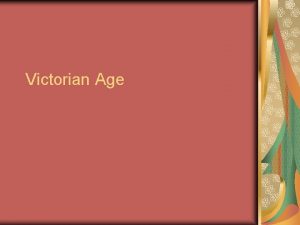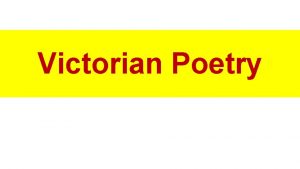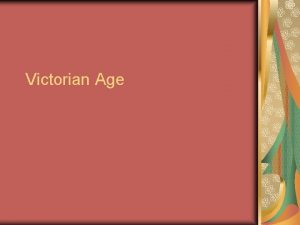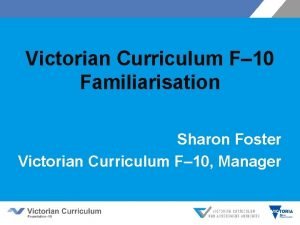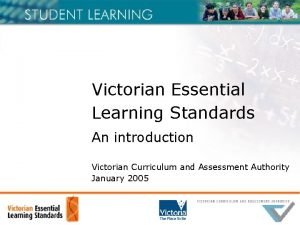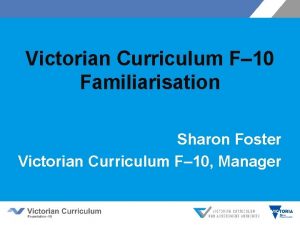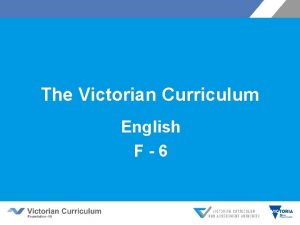Overview of Languages in the Victorian Curriculum F10













































- Slides: 45

Overview of Languages in the Victorian Curriculum F-10 (Secondary)

Agenda • • Overview of the Victorian Curriculum F-10 Languages in the Victorian Curriculum Learning area, moving from Aus. VELS to the Victorian Curriculum F-10, language specific approach • Timeline for Languages, structure, strands, content descriptions, elaborations Curriculum planning for Languages • Definition of curriculum, extracts from online tool, • Achievement standards, using rubrics for assessment • Extracts from secondary Languages curricula, intercultural capability • Online support materials • Web tour

Victorian Curriculum F-10 • Released in September 2015 as a central component of Education State, Victorian Curriculum F-10 • Provides a stable foundation for whole school curriculum planning • Incorporates the Australian Curriculum • Builds on VELS and Aus. VELS • Reflects Victorian standards and priorities.

Structure of the Victorian Curriculum F-10 • Learning Areas • Capabilities • • • The Arts • Dance • Drama • Media Arts • Music • Visual Communication Design (7 -10) • Visual Arts English Humanities • Civics and Citizenship • Economics and Business • Geography • History Languages Health and Physical Education Mathematics Science Technologies • Design and Technologies • Digital Technologies * Critical and creative thinking Intercultural capability Ethical capability Personal and social capability Structure and Design Victorian Curriculum is based on: • 8 learning areas • 4 capabilities

The Victorian Curriculum F-10: Languages The Languages curriculum focuses on both language and culture, and students • Learn to communicate across linguistic and cultural systems • Develop language awareness and intercultural skills and understandings • Develop openness to different experiences and perspectives • Develop skills in negotiating experiences and meanings across languages and cultures • Reflect on language use and language learning

Moving from Aus. VELS to the Victorian Curriculum F-10 • The Aus. VELS curriculum provided templates for different categories of languages • The Victorian Curriculum provides language specific curriculum documents - 20 in total when all completed.

Language specific curricula Language category Language specific curricula Roman Alphabet Languages 8 French Indonesian Spanish Vietnamese Non-Roman Alphabet Languages 5 Arabic Modern Greek Hindi Korean Non-Roman Alphabet Languages (Generic) Character Languages 2 Chinese Classical Languages 3 Classical Greek, Latin and Classical Framework* Sign Language 1 Australian Sign Language (Auslan)* 1 Aboriginal Languages and Torres Strait Islander Languages Victorian Aboriginal Languages* German Italian Turkish Roman Alphabet Languages (Generic) Japanese * Still to be completed

Timeline for Victorian Curriculum Languages 2013 -16 From 2016 • Victorian Curriculum available – language • Aus. VELS curriculum specific curricula being available • Aus. VELS website archived progressively released December 2016. • Implementation required from 2017.

Languages structural elements Sequences • An F-10 sequence for students who begin the study of the language in primary school • A 7 -10 sequence for students who begin the study of the language at Year 7. Note: Chinese also includes three pathways: • First language learner • Background language learner • Second language learner.

Strands and sub-strands 2 strands and 8 sub-strands Strand Substrands Communicating Understanding Socialising Systems of language Informing Language variation and change Creating The role of language and culture Translating Reflecting

Content descriptions and elaborations Content descriptions are: • Specific and discrete information identifying what teachers are expected to teach and students are expected to learn • Found within each sub-strand • Not a checklist. Elaborations are: • Non-mandated, advisory examples that provide guidance on how the curriculum may be transformed into a classroom activity or learning opportunity.

Using the content descriptions The aim is for the teaching and learning program to integrate the content descriptions into ‘topics’/units of work. A thematic approach across a range of learning areas will provide valuable contexts for student learning.


Curriculum • Defines what it is that all students have the opportunity to learn • Is represented as a continuum defining increasingly complex knowledge, skills and concepts • Each school develops the teaching and learning program - how the curriculum is delivered.

Importance of curriculum planning http: //curriculumplanning. vcaa. vic. edu. au/sat/self-assessment-tool

Importance of curriculum planning http: //curriculumplanning. vcaa. vic. edu. au/sat/self-assessment-tool

Achievement standards The learning sequence undertaken by students will determine their progression through the achievement standards, as follows: • F– 10 Sequence: the first achievement standard for Languages is provided for Foundation-Level 2, and then at Levels 3 -4, 5 -6, 7 -8 and 9 -10. • 7– 10 Sequence: the first achievement standard is provided at Levels 7 -8, and then at Levels 9 -10.

Levels of achievement F-10 Sequence: F-2 3 -4 5 -6 7 -8 9 -10 7 - 10 Sequence: 7 -8 9 -10 • The curriculum is represented on a continuum across the levels of achievement • For Languages, an achievement standard is provided for each band in both sequences.

Demonstrating achievement of standards • The achievement standards outline what the student is able to do • Students demonstrate what they are able to do through the products they present for assessment.

Assessment and reporting • Achievement standards as a continuum of language learning, not an age-determined set of expectations • Reporting in Victoria to be against the achievement standards • At times using assessment to adjust teaching.

Assessment “…performances on assessment tasks should be recorded using one or more task ‘rubrics’. ”(Masters) Rubrics: • Provide descriptions of observable characteristics of performance in an assessment task • Make explicit what is being looked for and valued as evidence of successful learning.

Demonstrating achievement of the standards • Rubrics or assessment criteria can be developed from the achievement standards • Units of work will probably address a number of aspects of the standard at any given level.

Assessing progress in the language • • Make assessment part of program design Have clear criteria (rubrics) Students discuss assessment criteria Collect evidence over term.

Creating a teaching and learning program Challenge: Turning the curriculum (what students should know) into teaching and learning programs that will engage and extend students learning in languages. Possible action: Could begin by mapping the current school languages program against the new Victorian Curriculum F-10.

Curriculum mapping • • Mapping identifies the extent of curriculum coverage in units of work and clearly links teaching, learning and assessment while working with the curriculum continuum. Mapping templates support teachers to identify where content descriptions and achievement standards are being explicitly addressed within the school’s teaching and learning program. Instructions: http: //www. vcaa. vic. edu. au/Pages/foundation 10/ viccurriculum/curriculumplanning. aspx Templates • For each Language • F - 10 • 7 - 10

Reporting • Schools will not be constrained by a one-size-fits-all approach • Schools have the flexibility to determine, in partnership with students, parents and the local community, the timing and format of their reports.

F-10 curriculum planning and reporting guidelines Provides guidelines on teaching and learning within stages of schooling: • Foundation (F-2) • Breadth (Years 3 -8) • Pathways (Years 9 -10) Provides guidelines on reporting of student achievement against a whole-school teaching and learning plan. http: //www. vcaa. vic. edu. au/Documents/viccurric/Revised. F-10 Curriculum. Planning. Reporting. Guidelines. pdf

Use of English Students are encouraged to use the language being studied as much as possible for classroom routines, social interactions, structured learning tasks, and language experimentation and practice. Students will have opportunities to engage with members of the community who speak the language being studied, which in some cases will be facilitated via digital technologies. English is used, where appropriate, for discussion and reflection, enabling students to share complex ideas about language and culture.

Victorian Curriculum - Italian Levels 7 and 8 Communicating Content description Content elaborations Socialising Socialise with peers and Socialising adults to exchange • greeting others, introducing themselves, expressing state of greetings, good wishes, health and wellbeing, appreciation and good wishes, and factual information and leave-taking, using appropriate familiar or formal language, opinions about self, for example, Mi chiamo … e tu? Come ti chiami? Ho 12 family and friends, anni. Sono Carla. Ciao Giorgio, come stai? (Sto) routines, shared events, bene/male, e tu? Mi dispiace. Ci vediamo domani. A leisure activities, domani. Buongiorno, Arriveder. La. Come si chiama? interests, likes and Buongiorno professoressa, come sta? dislikes • describing and comparing friends and family, for example, using [subject + verb + adjective]: Il mio amico è simpatico • describing routines, events and leisure activities (for example, Ogni weekend vado al cinema … Mi piace/non mi piace + [infinitive verb]. Gioco a/pratico il), and comparing these to similar events for Italian peers.

Achievement Standard: Extract from Levels 7/8 Italian (7 -10 sequence) Communicating strand By the end of Level 8 students • Engage in social interaction to exchange greetings and to share ideas and information related to their personal, social and school worlds • Use known phrases to exchange ideas and opinions, for example, Non mi piace la pallacanestro • Use language to interact and to respond to classroom instructions, questions and directions • Approximate Italian sound patterns such as consonant combinations, clear vowel sounds and unaspirated consonants • Use gesture and some formulaic expressions to support oral interaction • Use well-rehearsed language related to their personal experiences (for example, stating preferences in sports, leisure activities and entertainment).

Victorian Curriculum - Chinese Levels 7 and 8 Communicating Content description Socialising Correspond and collaborate with peers, relating aspects of their daily experiences and arranging sporting and leisure activities Content elaborations Socialising • • Participating in posting on a shared blog and exchanging personal information (for example, name, age, nationality, school and year level) with students from sister schools, (for example, 你好,我叫 Ann, 我是澳大利�的学生 ) Responding to correspondence (such as emails, letters or postcards) by answering questions, clarifying meaning (for example, 你�你想来澳大利�, 是�? ), seeking further information (for example, 你想一月份来�? ) and addressing requests, for example, 澳大利�一月是夏天,很� Using supporting images in own writing, for example, using emoticons such as >_<||| to enhance meaning in digital communication Using digital media to produce a bilingual publicity flier for an upcoming cultural or sporting event (for example, ��角 ), to promote Chinese learning among school community members.

Achievement Standard: Extract from Levels 7/8 Chinese (7 -10 sequence) Second Language Learner Pathway Communicating strand By the end of Level 8, students • Use spoken and written Chinese to interact in a range of familiar contexts • Respond to instructions, questions and directions • Use known phrases to exchange personal information (for example, 我叫…; 我的爸 爸是澳大利�人), seek clarification (for example, �不起,我听 不懂, 你�什么?), and transact and make arrangements, for example, 你要来我家 �? • Use the question particle � and familiar question words (什么,�,哪儿,几). • Approximate tone, intonation and rhythm but meaning remains clear • Use gesture and some formulaic expressions to support oral interaction.

Victorian Curriculum - Italian Levels 7 and 8 Understanding Content description Content elaborations Language variation and change Exploring the influence of technological change on the Italian language, such as: Analyse and understand • The borrowing and adapting of technical terms, for the dynamic nature of example, cliccare, il mouse, la password, chattare the Italian language, and • Observing the changes to language when used in of languages in general abbreviated forms in multimedia communications, for example, 6 = sei, x = per, + = più, - = meno, TVTB = ti voglio tanto bene, ke = che • Understanding the influence of other cultures on Italian, for example, the use of borrowed words such as il make-up, il bebé, un tailleur, il wurstel, il krapfen • Recognising that Italian is used in diverse communities and that it changes in response to local cultural contexts.

Achievement Standard: Extract from Levels 7/8 Italian 7 -10 sequence Understanding strand By the end of Level 8 students analyse the impact of technology and media on communication and language forms, the influence of Italian and English on one another, and the interrelationship of language and culture. They reflect on how they interpret and respond to aspects of Italian language and culture, and to intercultural experience, and identify how their response may be shaped by their own language(s) and culture(s).

Victorian Curriculum - French Levels 9 and Understanding Content description Role of Language and Culture Content elaborations Role of Language and Culture • Examining how changes to the French language reflect Explore the dynamic changes in some cultural practices and attitudes, for example, le fastfood, la pub/le pub, Madame le Directeur nature of the relationship • Sharing ideas about how culture ‘works’ as a combination between language, of beliefs, values and practices, and examining own culture and personal and community cultural frames of reference and communication and how and why these change over time it impacts on attitudes • Using personal journals and group discussions to reflect and beliefs (VCFRU 126) on how learning French has impacted on own assumptions about French language, culture or identity • Considering how the experience of learning a new language has impacted on awareness of own communicative and cultural behaviours and of how these may be interpreted by others.

Achievement Standard: Extract from Levels 9/10 French (7 -10 sequence) Understanding strand By the end of Level 10, students recognise the validity of different perspectives, and make comparisons across languages and cultures, drawing from texts which relate to familiar routines and daily life (la vie scolaire, la famille, les courses, les loisirs, la cuisine). They explain to others French terms and expressions that reflect cultural practices (bon appétit, bonne fête). They reflect on their own cultural identity in light of their experience of learning French, noticing how their ideas and ways of communicating are influenced by their membership of cultural groups.

Victorian Curriculum - German Levels 9 and 10 Communicating Content description Content elaborations Reflecting Reflect on self as a language user and discuss own and others’ cultural identity, considering how it is both shaped by and influences ways of communicating and thinking (VCDEC 028) Reflecting • • • Reflecting on the experience of learning German and considering how this might add a further dimension to own sense of identity, for example, by creating a persuasive text about the benefits of knowing another language Mapping own linguistic and cultural profile, such as by creating a web profile or a timeline of major milestones, highlighting formative elements such as family languages, key relationships and intercultural experiences, for example, Wann und warum benutze ich Englisch/Deutsch/X? Wie fühlte ich mich früher und wie fühle ich mich jetzt als Englisch-, Deutsch-, Xsprechende(r)? Warum ist es wichtig, dass ich eine neue Sprache lerne? Noticing and exploring how identity is expressed through languages spoken by people in various cultural contexts, including languages spoken by classmates and family or community members.

Achievement Standard: Extract from Levels 9/10 German (7 -10 sequence) Communicating strand By the end of Level 10, students • Explain the importance of audience and context in intercultural exchanges • Explain how cultural identity is both shaped by and influences ways of communicating and thinking • Reflect on their own cultural identity in light of their experience of learning German, identifying how their ideas and ways of communicating are influenced by their membership of cultural groups.

Intercultural Capability Intercultural capability aims to develop knowledge, understandings and skills to enable students to: • Demonstrate an awareness of and respect for cultural diversity within the community • Reflect on how intercultural experiences influence attitudes, values and beliefs • Recognise the importance of acceptance and appreciation of cultural diversity for a cohesive community. There are opportunities for teachers of Languages to support other teachers to work in this area of the curriculum.

Locating information

VCAA Curriculum Planning website The Curriculum Planning website offers a range of resources to support planning and documenting the curriculum. It includes a self-assessment tool and a suite of curriculum planning examples for both primary and secondary schools.

Curriculum planning website

Take the web tour Watch the videos: • Overview • Introduction • Using the view and filter options.

VCAA websites Victorian Curriculum F-10 Resources and Support http: //www. vcaa. vic. edu. au/Pages/foundation 10/viccurriculum/viccurrresources. aspx Victorian Curriculum F-10 http: //victoriancurriculum. vcaa. vic. edu. au Curriculum Planning Resources: http: //curriculumplanning. vcaa. vic. edu. au/home

Contact Details Maree Dellora Languages Manager dellora. maree. r@edumail. vic. gov. au Tel: 9032 1692
 Progression point scale victorian curriculum
Progression point scale victorian curriculum Victorian curriculum languages
Victorian curriculum languages Auma sa 10.2-f10 wiring diagram
Auma sa 10.2-f10 wiring diagram F10
F10 Victorian school of languages
Victorian school of languages Colonial williamsburg floral arrangements
Colonial williamsburg floral arrangements Early american floral designs
Early american floral designs Victorian curriculum health and physical education
Victorian curriculum health and physical education Different types of dinosaurs
Different types of dinosaurs Dance curriculum victoria
Dance curriculum victoria Hpe curriculum vic
Hpe curriculum vic Dance curriculum victoria
Dance curriculum victoria Stem victorian curriculum
Stem victorian curriculum Victorian curriculum intercultural capability
Victorian curriculum intercultural capability Victorian curriculum visual arts scope and sequence
Victorian curriculum visual arts scope and sequence Victorian history curriculum
Victorian history curriculum Ethical capability scope and sequence
Ethical capability scope and sequence Victorian curriculum art
Victorian curriculum art Critical and creative thinking vic curriculum
Critical and creative thinking vic curriculum Music victorian curriculum
Music victorian curriculum Historical concepts and skills
Historical concepts and skills Victorian curriculum japanese
Victorian curriculum japanese Eal continuum
Eal continuum Year 10 victorian curriculum
Year 10 victorian curriculum Victorian curriculum digital technologies
Victorian curriculum digital technologies Victorian curriculum technology
Victorian curriculum technology Victorian curriculum economics
Victorian curriculum economics Victorian curriculum eal
Victorian curriculum eal Victorian curriculum economics
Victorian curriculum economics Victorian curriculum the arts
Victorian curriculum the arts Progression points victorian curriculum english
Progression points victorian curriculum english Leanne compton
Leanne compton Eal pathways
Eal pathways Vẽ hình chiếu vuông góc của vật thể sau
Vẽ hình chiếu vuông góc của vật thể sau Công của trọng lực
Công của trọng lực Làm thế nào để 102-1=99
Làm thế nào để 102-1=99 Tỉ lệ cơ thể trẻ em
Tỉ lệ cơ thể trẻ em Thế nào là mạng điện lắp đặt kiểu nổi
Thế nào là mạng điện lắp đặt kiểu nổi Lời thề hippocrates
Lời thề hippocrates đại từ thay thế
đại từ thay thế Vẽ hình chiếu đứng bằng cạnh của vật thể
Vẽ hình chiếu đứng bằng cạnh của vật thể Quá trình desamine hóa có thể tạo ra
Quá trình desamine hóa có thể tạo ra Môn thể thao bắt đầu bằng chữ f
Môn thể thao bắt đầu bằng chữ f Hát kết hợp bộ gõ cơ thể
Hát kết hợp bộ gõ cơ thể Sự nuôi và dạy con của hươu
Sự nuôi và dạy con của hươu Dạng đột biến một nhiễm là
Dạng đột biến một nhiễm là
